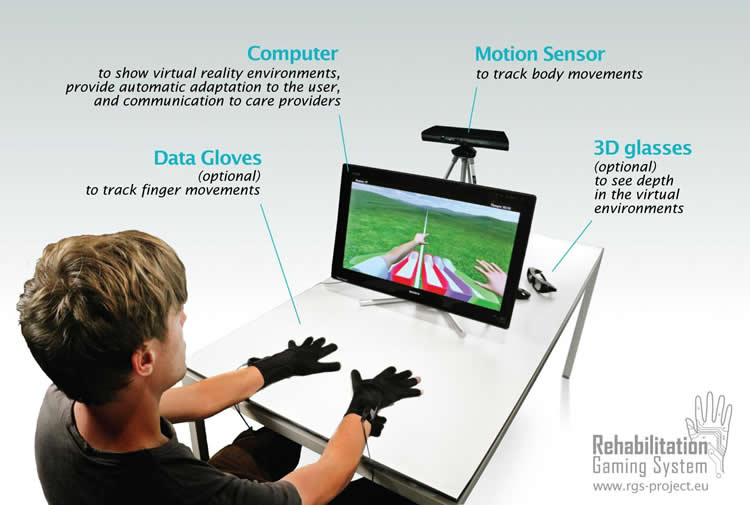Using virtual reality to increase a patient’s confidence in using their paralyzed arm may be critical for recovery, according to research published in the open-access Journal of NeuroEngineering and Rehabilitation.
Virtual reality could assist arm rehabilitation in some stroke patients, according to a clinical pilot study published in the open access Journal of NeuroEngineering and Rehabilitation. The researchers found that using virtual reality to increase a patient’s confidence in using their paralyzed arm may be critical for recovery.
Stroke patients with ‘hemiparesis’ – reduced muscle strength on one side of the body – often underuse their affected limbs even though they still have some motor function.
Using their healthy limb may immediately improve the ease of their daily activities, but a long period of non-use of the affected ‘paretic’ limb can lead to further loss of function. This so-called ‘learned non-use’ is a well-known effect in stroke patients and has been associated with a reduced quality of life.
The small pilot study involved 20 hemiparetic stroke patients using the ‘Rehabilitation Gaming System’ with a Microsoft Kinect sensor. The system allows users to control a virtual body via their own movements, seen from a first-person perspective on a computer screen, with which they perform tasks in a virtual world.
Lead author, Belén Rubio from the Laboratory of Synthetic, Perceptive, Emotive and Cognitive Systems, Universitat Pompeu Fabra, Spain, said: “There is a need for designing new rehabilitation strategies that promote the use of the affected limb in performing daily activities. Often we neglect the remarkable contribution of the patient’s emotional and psychological states to recovery, and this includes their confidence.”
Participants were asked to reach targets appearing in a virtual environment over several blocks of trials. In some of these trials, the researchers enhanced the movement of the paretic limb’s virtual representation, making it appear faster, more accurate and easier to reach the target on screen. These amplifications were introduced and suppressed in a gradual fashion to keep participants unaware of the manipulations.
Following these manipulations, the participants’ performance in the unamplified task was recorded, including the likelihood of them using their paretic limb.
Belén Rubio said: “After enhancement of movement, patients started using their paretic limb more frequently. This suggests that changing patients’ beliefs on their capabilities significantly improves the use of their paretic limb. Surprisingly, only ten minutes of enhancement was enough to induce significant changes in the amount of spontaneous use of the affected limb.”
Following the intervention, there was a significantly higher probability that the patient would select their paretic limb for reaching towards a virtual target. This was despite there being no amplification of movement in that session, and the patient reporting no awareness of the previous session’s manipulation.

Some current therapies for stroke patients involve forcing the patient to use the affected limb by constraining movement of the healthy limb, for example, in ‘Constraint Induced Movement Therapy’. This study suggests that an alternative focus on increasing the patient’s confidence in using the paretic arm may instead be critical for full recovery.
Belén Rubio said: “This therapy could create a virtuous circle of recovery, in which positive feedback, spontaneous arm use and motor performance can reinforce each other. Engaging patients in this ongoing cycle of spontaneous arm use, training and learning could produce a remarkable impact on their recovery process.
“This study is one among many in which the Rehabilitation Gaming System (RGS) has been validated over the last ten years. There is now overwhelming evidence that RGS has a significant impact on recovery of functionality for both acute and chronic patients, and it is currently in daily use in a number of hospitals and treatment centers in Spain.”
The study will need to be repeated with a larger number of participants to provide more insight into the use of the RGS-based virtual reality intervention as an effective therapy.
RGS is being commercialized via a spin-off company Eodyne.com.
Source: Joel Winston – Biomed Central
Image Credit: The image is credited to Rehabilitation Gaming System
Original Research: Full open access research for “The visual amplification of goal-oriented movements counteracts acquired non-use in hemiparetic stroke patients” by Belén Rubio Ballester, Jens Nirme, Esther Duarte, Ampar Cuxart, Susana Rodriguez, Paul Verschure and Armin Duff in Journal of Neuroengineering and Rehabilitation. Published online June 9 2015 doi:10.1186/s12984-015-0039-z
Abstract
The visual amplification of goal-oriented movements counteracts acquired non-use in hemiparetic stroke patients
Background
Stroke-induced impairments result from both primary and secondary causes, i.e. damage to the brain and the acquired non-use of the impaired limbs. Indeed, stroke patients often under-utilize their paretic limb despite sufficient residual motor function. We hypothesize that acquired non-use can be overcome by reinforcement-based training strategies.
Methods
Hemiparetic stroke patients (n = 20, 11 males, 9 right-sided hemiparesis) were asked to reach targets appearing in either the real world or in a virtual environment. Sessions were divided into 3 phases: baseline, intervention and washout. During the intervention the movement of the virtual representation of the patients’ paretic limb was amplified towards the target.
Results
We found that the probability of using the paretic limb during washout was significantly higher in comparison to baseline. Patients showed generalization of these results by displaying a more substantial workspace in real world task. These gains correlated with changes in effector selection patterns.
Conclusions
The amplification of the movement of the paretic limb in a virtual environment promotes the use of the paretic limb in stroke patients. Our findings indicate that reinforcement-based therapies may be an effective approach for counteracting learned non-use and may modulate motor performance in the real world.
“The visual amplification of goal-oriented movements counteracts acquired non-use in hemiparetic stroke patients” by Belén Rubio Ballester, Jens Nirme, Esther Duarte, Ampar Cuxart, Susana Rodriguez, Paul Verschure and Armin Duff in Journal of Neuroengineering and Rehabilitation. Published online June 9 2015 doi:10.1186/s12984-015-0039-z






